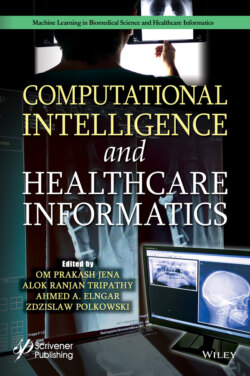Читать книгу Computational Intelligence and Healthcare Informatics - Группа авторов - Страница 42
2.2.1 Challenges
ОглавлениеThere are various challenges while implementing deep learning models for analysis of thoracic images and these challenges are listed below. They could be in terms of availability of dataset and nature of images.
Figure 2.1 Broad view of existing research.
1 Non-availability of large number of labeled dataset [16].
2 Due to use of weights of neural nets trained on ImageNet dataset for ensemble model, overfitting problem occurs. Theses pre-trained models are computationally intensive and are less likely to generalize for comparatively smaller dataset [7].
3 Presence of lesions at different location in x-ray and varying proportion of images of each pathology might hinders performance of models [41].
4 X-ray images contain large amount of noise (healthy region) surrounding to lesion area which is very small. These large numbers of safe regions make it impossible for deep networks to concentrate on the lesion region of chest pathology, and the location of disease regions is often unpredictable. This problem is somewhat different from the classification of generic images [67], where the object of interest is normally located in the center of the image.
5 Due to the broad inter-class similarity of chest x-ray images, it is difficult for deep networks to capture the subtle differences in the entire images of different classes, particularly in one entire image.
6 CXR images suffer from distortion or misalignment due to variations in the capture state, e.g., the patient’s pose or the small size of the child’s body.
7 Sometimes, recapturing of images is not possible due to which computer-aided system has to do prediction on the basis of existing images only. Therefore, model should be vigorous to quality of x-ray image.
8 For localization of pathologies, images should be labeled or annotated with bounding boxes and for segmentation pixel-level mask is needed in the image. Both these processes are expensive and time consuming process.
9 Output of CNN is not shift invariant meaning that if input image is shifted then output of CNN also shifted which should not happen in the domain of medical imaging.
10 Imbalance between availability of number of normal class images and images with disorders and disproportion of availability of annotated and unannotated images.
11 Most of the models are trained for ImageNet data set which has altogether different features as compared to medical images [5].
12 Confounding variables in the x-ray images ruin the performance of models therefore there is a need of pre-processing [72].
To overcome these issues, following strategies can be deployed.
1 2-D or 3-D image patches are taken as an input rather than full sized image [11, 14, 36, 50, 56–58, 63].
2 Annotate existing images using affine transformation and expand existing dataset by adding annotated image with existing images, and then, network will be trained from scratch on expanded dataset [11, 50, 56, 57].
3 Use of deep models trained on off-the shelf dataset for feature extraction and then use final classifier at last layer for classification by fine tuning the model with target dataset [14, 36, 58].
4 Initialize parameters of new models with value of parameters of pre-trained models applied on ImageNet dataset [60] and then fine tune the network with task specific dataset.
